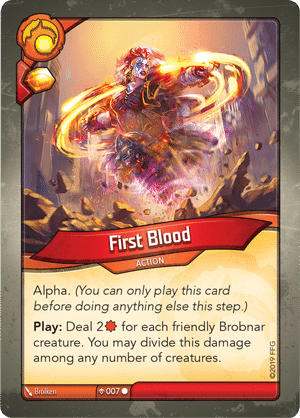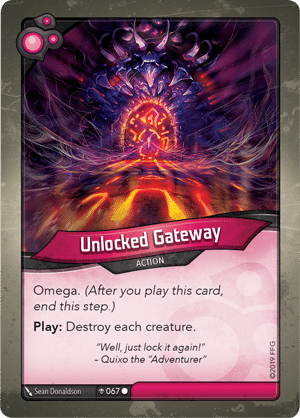The release of the Age of Ascension set for the boomingly popular Keyforge card game is drawing nearer and nearer, and I couldn’t be more excited! Over 700,000 unique decks have been registered in The Master Vault – and over a dozen of them reside in my home. There was a time when I thought, “You know, I could start saving up to snag a handful of decks in this new set when it drops.” But then I just went and bought more Call of the Archons decks because a) Why not? and b) They’ll still play!
The Age of Ascension does not mark the end of the line for Call of the Archons decks. We’re being told that Age of Ascension – as well as future sets – will be designed in such a way that does not make older sets necessarily obsolete. So by all means: Keep snagging those Call of the Archons decks!
But if that’s the case, what exactly does Age of Ascension bring to the table? A few noteworthy things, for sure! Let’s run them down quickly for you:
New Keywords in Age of Ascension
When Age of Ascension was first announced, our resident Magic the Gathering and Keyforge expert, Alex, posted a quick announcement that touched on the new keywords as well as a few of the revealed cards. I want to spend a touch more time on the keywords here.
Keyforge is GREAT at telling you right on the card face what these keywords mean and how they are meant to operate, but let’s review them below and look at a couple of examples.
Alpha
You can only play this card before doing anything else this step.
Named after the first letter of the Greek alphabet, Alpha cards must be played before performing any other action on your turn – excepting forging a Key if you’ve got enough æmber and declaring your House. Before you Play, Discard, or Use any other card, a card with this keyword must make its appearance if you plan on using it.
These cards’ effects will be dependent on the board state and æmber pools at the beginning of a turn. Playing them first limits your ability to work around certain conditions or enhance the effects of others while also giving your opponent the opportunity to affect the board state and pools.

Take the new card, First Blood, for instance. Because it has the Alpha keyword, you cannot draw a handful of Brobnar cards, fill the battleline with Brobnar creatures, and then, on the same turn, maximize the potential of First Blood. You could fill your battleline up one turn and then pop First Blood the next if you’d like…but not before your opponent has a chance to pop a Brobnar creature or two.
Or in the case of Binate Rupture, you cannot Reap with a load of Logos creatures and/or play several actions that generate æmber and then double your pool. Instead, you’ll have to do your best to build up your pool and whittle down that of your opponents a turn before you play Binate Rupture, which, again, gives your opponent a chance to fiddle with the numbers.
In neither case will your opponent necessarily know what you’re up to, though, so you definitely have a chance for some big returns on planned plays.
Omega
After you play this card, end this step.
Named after the last letter of the Greek alphabet, Omega cards will signal the end of the third step of your turn during which you are free to Play, Discard, or Use your cards.
Omega cards will tend to significantly effect future turns for either you and/or your opponent. Some will have effects that cannot be avoided while others will threaten major plays if your opponent doesn’t deal with them promptly.

I’ve got a deck that is heavy on Dis creatures, has a Gateway to Dis, and two copies of Arise. This means I could drop Gateway at the start of a turn, pop all creatures on the board, play Arise and select House Dis, then play all of the Dis creatures I returned to my hand from the discard pile along with any others I might have already had in hand. Unlocked Gateway’s Omega keyword prevents that kind of play! Because it is the last thing I can do on my turn, it guarantees that both I and my opponent will begin our next turns with no creatures on the board. Unavoidable! It should be noted, too, that Unlocked Gateway does not come with any Chains as does Gateway to Dis!
Duskwitch, on the other hand, gives your opponent a chance to block a powerful card effect. It doesn’t make it easy with that Elusive quality, but it can be done. If they don’t pop this creature on their next turn, all of your creatures are going to come into play readied – which is a HUGE advantage. Duskwitch is a more selective and more powerful form of Speed Sigil. But because of her Omega keyword, you can’t take immediate advantage of her boon (like you could with, say, Hunting Witch).
Deploy
This creature can enter play anywhere on your battleline.
Normally creatures must enter play on either the left or right flank. Not so with creatures who feature the Deploy keyword!
Deploy adds a new wrinkle of strategy to creature placement in more than one way. It will help you keep certain creatures that benefit from remaining on the flanks in their places of power (like Staunch Knight or Titan Mechanic), and it will give you new control over creature placement between the flanks.

I can’t tell you how many times I’ve been disappointed in the neighbors I’ve had to place adjacent to Shadow Self or Bulwark only to draw the cards I wanted next to them later in the game. Deploy is going to let you be much more selective and strategic with those buffs, which I absolutely love. In fact, I would super love to see some cards that need those buffs have the Deploy keyword, too. That way if you’ve already got your buffers on the field you could still squeeze in the squishy but pesky cards next to them for protection!
Legacy Cards
Call of the Archons featured of set 370 cards which allows for a more than 100 septillion unique combinations. A single septillion is a 1 followed by 24 friggin’ zeroes, yo. TWENTY. FOUR. And there are a hundred of those.
Age of Ascension features the same number of cards featured in Call of the Archons (370), which means it, too, boasts 100+ septillion combinations. But not every card in Age of Ascension will be a new card.
204 of the 370 will be brand spanking new and may feature one or more of the keywords outlined above. The remaining 166 will be drawn from Call of the Archons. However there will be Call of the Archons cards that are not featured in the 166 older cards in Age of Ascension, but will still make appearances in Age of Ascension. These are called Legacy Cards and are likely to be pretty rare finds.
One we know of for sure is Quixo the “Adventurer” (see this official announcement from Fantasy Flight). Quixo is not among the 166 featured cards, but that doesn’t mean you won’t see him in any Age of Ascension decks. I imagine these cards will feature a symbol of some kind like Mavericks? Heck, there might even be some Legacy cards that are also Maverick cards! Those would be super duper rare. We won’t really know until the set is out.
What we do know is that the very idea of Legacy cards means that there is an even greater real pool of cards for the algorithms to play with which means even more possible unique decks. You know, because 104 septillion isn’t enough.
Age of Ascension: A Little Goes a Long Way
So, yeah, it is “just” three new keywords and the new set’s featured card pool consists of “only” 55% brand new cards instead of 100%. But, Lordy, that is still a lot. Can you even count to septillion, or visualize that number?!
Plus it keeps Call of the Archons decks viable and competitive, which is a smart move! There isn’t really necessarily a new meta with Age of Ascension, just a few new ways and faces to play with in the format we already love; a bit of the new and exciting mixed in with the familiar.
The Master Vault will crest 1 million decks in no time flat after Age of Ascension drops, I think.

